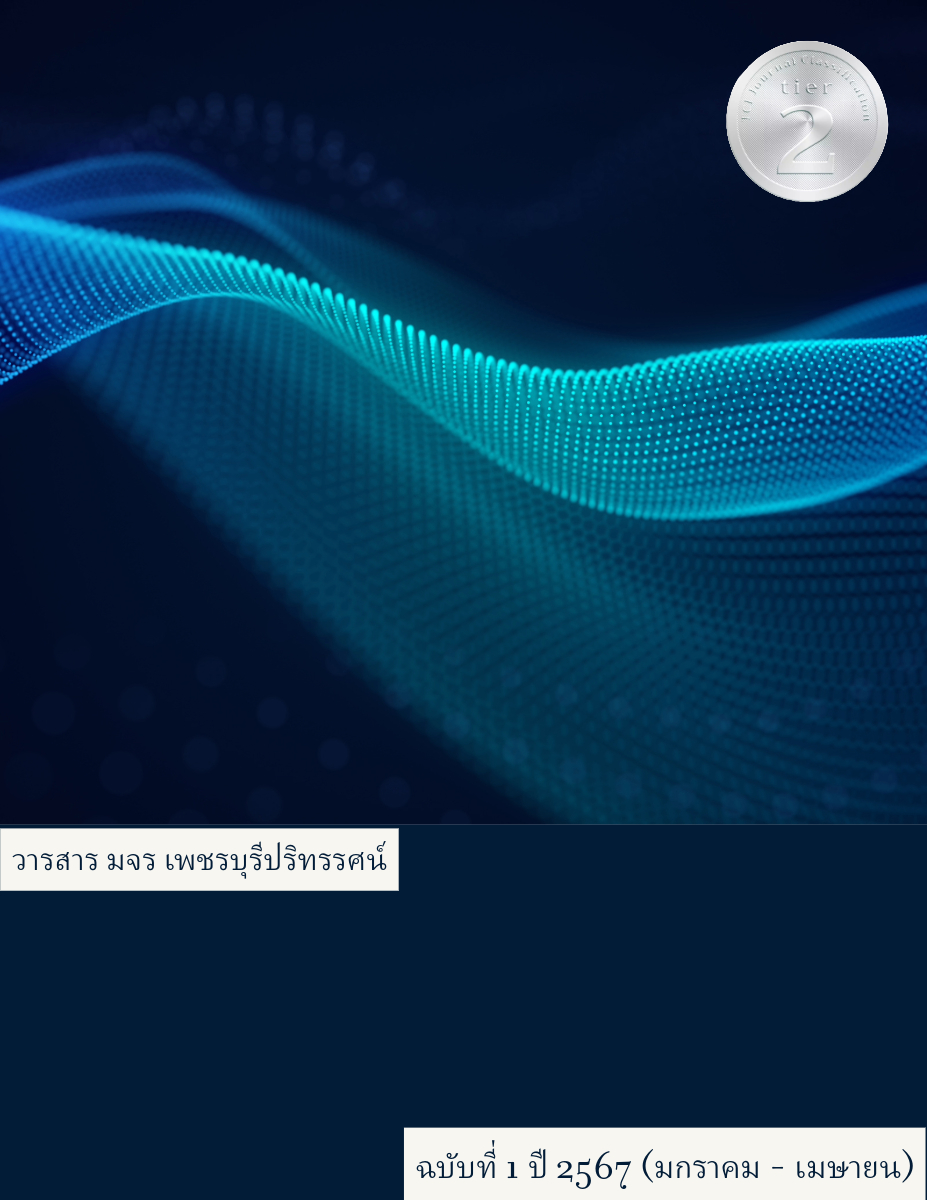EXECUTIVE COMPETENCY DEVELOPMENT MODEL IN THE POWER TRANSFORMER MANUFACTURING INDUSTRY IN THAILAND
Main Article Content
Abstract
This research has the following objectives 1) to study the problems and needs in developing the competencies of executives in the power transformer manufacturing industry in Thailand. 2) to analyze the components of developing the competencies of executives in the power transformer manufacturing industry in Thailand. Thailand 3) to synthesize mechanisms for enhancing the competency of executives in the electrical power transformer manufacturing industry in Thailand, and 4) to develop the competencies of executives in the electrical power transformer manufacturing industry in Thailand. This research is a mixed methods research. Consists of quantitative research The quota sampling method was used. The sample size was determined according to the criteria of Hare and colleagues (2010), collecting a sample of 400 executives. Qualitative research section Using a referral sampling method with word-of-mouth recommendations, 10 people were executives. The tools used to collect data are questionnaires and interviews. Statistics used in data analysis include number, percentage, mean, and standard deviation. and analyze the structural equation model.
The results of the study found that (1) the problem conditions and needs for the development of competencies of most executives were at a high level, i.e. knowledge aspect, with an average of =3.90, S.D.=0.85 (2) components of competency development of executives Management, first of all, is attitude and characteristics. The average value is =4.06, S.D.=0.86 (3) The mechanism for enhancing the competency of executives is the strategic control and evaluation stage. has a mean of =4.25, S.D.=0.79 (4) The development of executive competency was found to be harmonious and consistent with the research model simulation model. The index measures the level of consistency of the model. Chi-square=213.248 df=220 p=.615 CMIN/df=.969 GFI=.956 AGFI=.945 NFI=.966 CFI=1.00 RMSEA=.000 and RMR=.016
Article Details

This work is licensed under a Creative Commons Attribution-NonCommercial-NoDerivatives 4.0 International License.
References
สำนักงานนโยบายและแผนพลังงาน. (2563). แผนพัฒนากำลังผลิตไฟฟ้าของประเทศไทยพ.ศ. 2558 – 2579 (PDP2015). กรุงเทพฯ: สำนักงานนโยบายและแผนพลังงาน.
เรวัต สุนทรวิภาต และคณะ (2563). รูปแบบการพัฒนาสมรรถนะผู้บริหารธุรกิจอุตสาหกรรมยานยนต์สมัยใหม่. วิทยานิพนธ์ บธ.ด. กรุงเทพฯ มหาวิทยาลัยเทคโนโลยีพระจอมเกล้าพระนครเหนือ.
สุชาดี ธำรงสุข (2563). การพัฒนารูปแบบสมรรถนะของผู้บริหารสนามบินนานาชาติเพื่อการแข่งขันในอุตสาหกรรมการบินยุคดิจิทัล. วิทยานิพนธ์ บธ.ด. กรุงเทพฯ มหาวิทยาลัยเทคโนโลยีพระจอมเกล้าพระนครเหนือ.
อิทธิศักดิ์ อักษรเวช. (2564). รูปแบบการพัฒนาสมรรถนะของผู้บริหารสำนักงานที่ดินจังหวัดและสาขาในภาคตะวันออกเฉียงเหนือตอนกลาง. วิทยานิพนธ์ รป.ด. มหาสารคาม มหาวิทยาลัยราชภัฏมหาสารคาม.
นปภา มณีรัตน์. (2563). รูปแบบสมรรถนะของผู้บริหาร ในการบริหารทรัพยากรมนุษย์ของอุตสาหกรรม ผลิตชิ้นส่วนยานยนต์ ในภาคตะวันออก. วารสารสังคมศาสตร์. 9(1). 60-69.
สุภาพร เพ่งพิศ. (2563). ปัจจัยที่มีอิทธิพลต่อพฤติกรรมการสร้างสรรค์นวัตกรรมของพนักงานกลุ่มโรงงานอุตสาหกรรมในจังหวัดนครปฐม. วารสารบริหารธุรกิจและสังคมศาสตร์ มหาวิทยาลัยรามคำแหง. 3(3). 131-146.
สุพิเชษฐ์ ตองอ่อน และประสพชัย พสุนนส์. (2563). การวิเคราะห์ความสัมพันธ์ระหว่างปัจจัยสมรรถนะของบุคลากรกับการสร้างนวัตกรรมในองค์การ โดยมีการสนับสนุนของผู้นำองค์การเป็นตัวแปรส่งผ่านของบุคลากรมหาวิทยาลัยศรีนครินทรวิโรฒ. RMUTT Global Business and Economics Review. 15(1). 16-25.
พภัสสรณ์ วรภัทร์ถิระกุล. (2562). แรงจูงใจในการปฏิบัติงานของบุคลากรที่มีผลต่อการบริหารงานสำนักงานรักษาความปลอดภัยแห่งชาติ เขตพื้นที่ 13 (กรุงเทพฯ). วารสารมหาจุฬานาครทรรศน์. 6(1). 486-498.
สุทธิพงค์ แก้วเสน สมนึก วิสุทธิแพทย์ ปรีดา อัตวินิจตระการ และ ทวีศักดิ์ รูปสิงห์. (2565). รูปแบบการพัฒนาสมรรถนะผู้บริหารในอุตสาหกรรมโรงไฟฟ้าชีวมวลขนาดเล็กมาก. วารสารวิชาการพระจอมเกล้าพระนครเหนือ. 32(4). 1066-1074.
ภาวิดา อภินันท์ธรรม และสมนึก วิสุทธิแพทย์ (2563) ภาวิดา อภินันท์ธรรม และสมนึก วิสุทธิแพทย์. (2563). การพัฒนารูปแบบสมรรถนะของผู้บริหารธุรกิจออนไลน์ในยุคเศรษฐกิจดิจิทัล. วารสารวิชาการพระจอมเกล้าพระนครเหนือ. 30(1). 159-169.
ประภัสสร ไตรลาภวิฒิ, บุษกร วัฒนบุตร, และนันทนา ชวศิริกุลฑล. (2563). แนวทางการพัฒนาทุนมนุษย์ในการขับเคลื่อนองค์กรสู่ความสำเร็จ. วารสารการบริหารการปกครองและนวัตกรรมท้องถิ่น. 4(3). 157-170.
Tsendsuren et al. (2021). Tsendsuren, C., Yadav, P. L., Han, S. H., & Kim, H. (2021). Influence of product market competition and managerial competency on corporate environmental responsibility: Evidence from the US. Journal of Cleaner Production. 304. 127065.
Hair, J.F., Black, W.C., Babin, B.J. and Anderson, R.E. (2010) Multivariate Data Analysis. 7th Edition, Pearson, New York.
Daouk‐Öyry et al. (2021) Daouk‐Öyry, L., Sahakian, T., & van de Vijver, F. (2021). Evidence‐based management competency model for managers in hospital settings. British Journal of Management, 32(4), 1384-1403.
บุญชม ศรีสะอาด และคณะ. (2558). พื้นฐานการวิจัยการศึกษา. (พิมพ์ครั้งที่ 7). กาฬสินธุ์: ตักสิลาการพิมพ์.
ล้วน สายยศ และอังคณา สายยศ. (2543). การวัดด้านจิตพิสัย. กรุงเทพฯ: สุวีริยาสานส์น.


